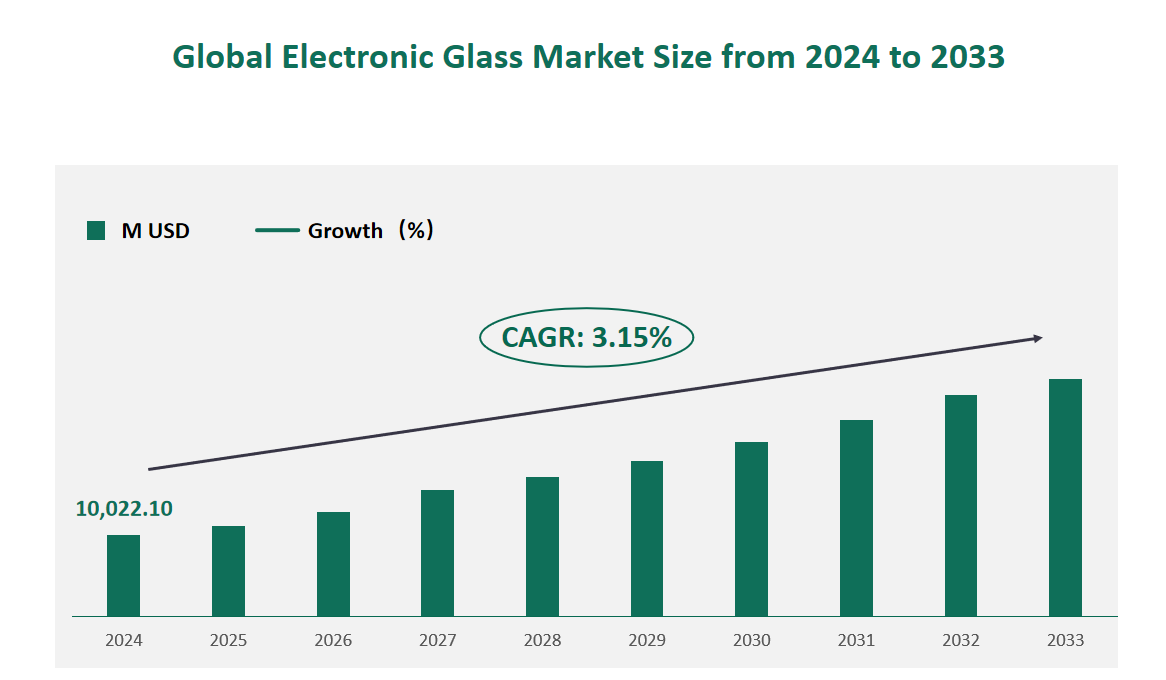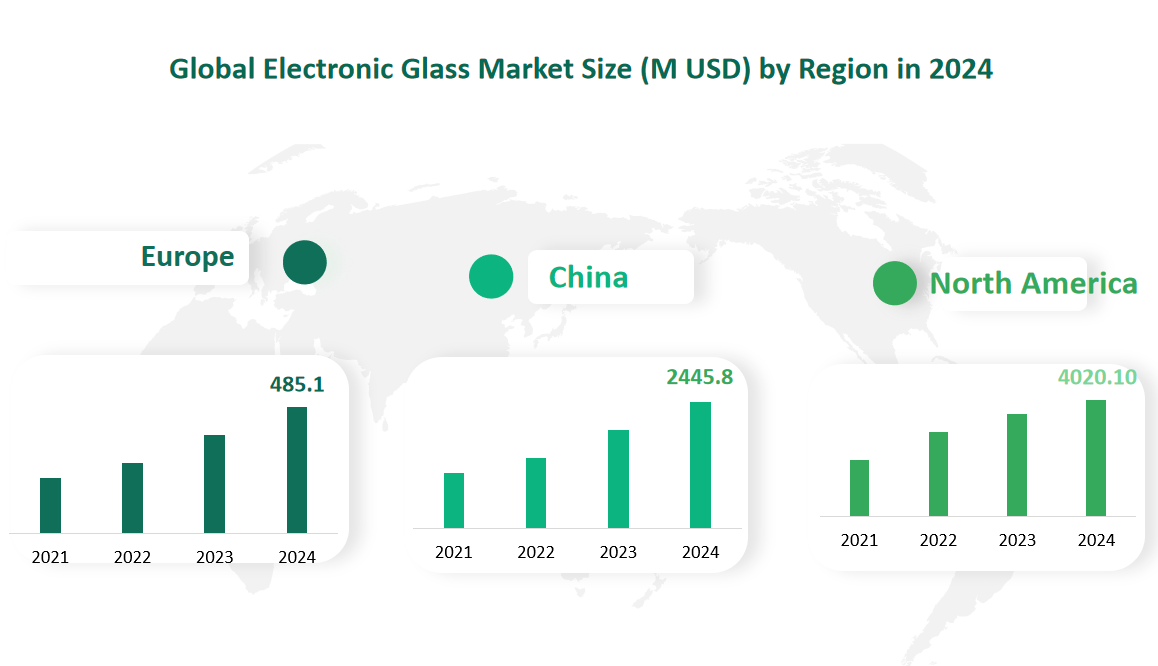1 Global Electronic Glass Market Size (Value) and CAGR (2024-2033)
In 2024, the global Electronic Glass market was valued at USD 10,022.10 million, with a CAGR of 3.15% from 2024 to 2033.
Electronic glass generally refers to float glass of 0.1~2mm thickness, which is used in smartphones, tablet PCs, laptops, smart watches, car applications, public enquiry systems, ATM machines and other fields.
Figure Global Electronic Glass Market Size (M USD) and CAGR 2024-2033

2 Electronic Glass Market Drivers
Technological Advancements
Continuous technological advancements in the electronics industry are driving the need for high-quality electronic glass. Manufacturers are constantly pushing the boundaries of what is possible with glass materials, developing thinner, stronger, and more flexible options. These advancements are essential for meeting the demands of modern electronic devices, which require materials that can support advanced features such as foldable screens and high-definition displays.
Growing Demand for High-Performance Displays
The demand for high-performance displays is a key driver for the Electronic Glass market. Consumers are increasingly looking for devices with larger, thinner, and more durable screens. This trend is driving the adoption of advanced glass materials that can provide superior optical clarity, scratch resistance, and flexibility. The growth of the gaming and multimedia industries is also contributing to the demand for high-quality displays, further fueling the market.
Increasing Use of Smart Devices
The proliferation of smart devices, including smartphones, tablets, smartwatches, and smart home devices, is driving the demand for electronic glass. These devices require high-quality glass materials to support their advanced features and functionalities. The increasing use of touchscreens and high-definition displays in these devices is particularly driving the demand for electronic glass.
3 Electronic Glass Market Challenges
Stringent Certification Requirements
One of the primary challenges in the Electronic Glass market is the stringent certification requirements imposed by downstream electronics manufacturers. To sell electronic glass products, manufacturers must pass rigorous product certifications, ensuring that their materials meet the high standards required by the electronics industry. This process involves multiple stages, including certifications from cover factories, TP factories, and system makers, making it difficult for new entrants to gain a foothold in the market.
Dominance of Established Players
The market is highly concentrated, with a few major players such as Corning, AGC, and NEG dominating the industry. These companies have established strong market positions and brand reputations, making it challenging for new entrants to compete. The high barriers to entry, including the need for significant R&D investment and advanced manufacturing capabilities, further limit the number of new players entering the market.
4 Global Electronic Glass Market Size and Share by Type in 2024
In 2024, Display Glass is projected to account for the largest share of the market, with a value of $6,557.93 million. Display Glass is specifically designed for use in high-performance display panels, such as those found in smartphones, tablets, laptops, and televisions. It is characterized by its high transparency, excellent optical properties, and durability. Display Glass is crucial for supporting advanced display technologies like OLED and LCD, which require materials that can provide superior image quality and energy efficiency. The growth of high-definition and ultra-high-definition displays, along with the increasing adoption of OLED and LCD technologies, is driving the demand for Display Glass.
Smartphone Cover Glass is another significant segment, with a market value of $2,832.94 million in 2024. Smartphone Cover Glass is designed to protect the screens of smartphones and other mobile devices. It is engineered to be highly scratch-resistant, impact-resistant, and flexible, ensuring that devices can withstand daily wear and tear. This type of glass is also optimized for touch sensitivity and optical clarity, providing a seamless user experience. The growing trend towards thinner and lighter devices, along with the increasing popularity of foldable screens, is driving the development of advanced cover glass materials.
Table Global Electronic Glass Market Size and Share by Type in 2024
Type | Market Size (M USD) 2024 | Market Share 2024 |
Display Glass | 6557.93 | 65.43% |
Smartphone Cover Glass | 2832.94 | 28.17% |
Others | 631.24 | 6.30% |
5 Global Electronic Glass Market Consumption (M Sqm) by Application in 2024
The Commercial sector is anticipated to consume 488.6 million square meters of electronic glass in 2024. This application includes a wide range of uses such as digital signage, public information displays, and commercial touchscreens. The demand is driven by the increasing need for high-quality, durable displays that can withstand constant use and environmental factors. Electronic glass in this sector often requires higher scratch resistance and optical clarity to ensure clear visibility and functionality.
Residential applications are expected to consume 416.5 million square meters of electronic glass. This includes uses in smart home devices, residential touchscreens, and various consumer electronics. The demand is influenced by the growing trend of smart homes and the need for user-friendly interfaces. Electronic glass in residential applications often focuses on aesthetics and ease of use, with a strong emphasis on touch sensitivity and durability.
The Medical sector is projected to consume 112.0 million square meters of electronic glass. This application includes medical devices, diagnostic equipment, and hospital information systems. The demand is driven by the need for high-precision, durable, and sterile materials that can withstand rigorous medical environments. Electronic glass in this sector often requires high transparency and resistance to chemicals and radiation.
Table Global Electronic Glass Market Consumption (M Sqm) by Application in 2024
Application | Market Consumption (M Sqm) 2024 |
Commercial | 488.6 |
Residential | 416.5 |
Medical | 112.0 |
Others | 66.7 |
6 Global Electronic Glass Market Size by Region in 2024
North America is expected to contribute $4020.10 million to the global Electronic Glass market in 2024. The region’s market is driven by technological advancements and high demand for advanced electronic devices. The United States, in particular, is a major consumer of electronic glass, with significant contributions from the tech industry. The demand is influenced by the need for high-performance materials in consumer electronics and industrial applications.
Europe is projected to contribute $485.1 million to the market. The region’s market is characterized by a strong focus on quality and innovation. Countries like Germany and the UK are significant consumers of electronic glass, driven by the automotive and electronics industries. The demand is influenced by the need for durable and high-quality materials in various applications.
China is expected to be the largest market, contributing $2445.8 million in 2024. This region’s market is driven by the rapid growth of the electronics industry. The demand is influenced by the increasing production of smartphones, tablets, and other consumer electronics.
Figure Global Electronic Glass Market Size by Region in 2024

7 Major Players in Global Electronic Glass Market
7.1 Corning
Company Profile:
Corning is a leading manufacturer of specialty glass and ceramics, with a history dating back to 1851. Headquartered in Corning, New York, the company operates globally, with manufacturing sites in North America and Asia. Corning’s business segments include Display Technologies, Optical Communications, Environmental Technologies, Specialty Materials, and Life Sciences. The company is renowned for its innovative products and technologies, such as Gorilla Glass, which is widely used in smartphones and other electronic devices.
Business Overview:
Corning’s Display Technologies segment manufactures glass substrates for flat panel liquid crystal displays and other high-performance display panels. The company’s Optical Communications segment provides carrier network and enterprise network components for the telecommunications industry. Corning’s Specialty Materials segment produces over 150 material formulations for glass, glass ceramics, and fluoride crystals. The Environmental Technologies segment manufactures ceramic substrates and filters for automotive and diesel applications, while the Life Sciences segment focuses on labware, equipment, and reagents for drug discovery and bioproduction.
Product Introduction:
Corning’s Gorilla Glass Victus is a standout product, offering improved drop performance, high resistance to scratches and sharp contact damage, and superior surface quality. It is used as a protective cover material for various electronic devices, including smartphones, tablets, smartwatches, and smart home devices. Gorilla Glass Victus is designed to withstand drops from up to 2 meters onto hard, rough surfaces, making it a preferred choice for device manufacturers.
Recent Financial Data:
In the most recent year, Corning’s revenue from electronic glass was $4,877.87 million, with a gross margin of 53.03%.
7.2 AGC
Company Profile:
AGC, established in 1907 and headquartered in Tokyo, Japan, is a global leader in the glass manufacturing industry. The company operates primarily in Asia but serves customers worldwide. AGC’s business segments include Glass, Electronics, and Chemicals, with a diverse product portfolio ranging from float plate glass to high-tech materials for electronic devices.
Business Overview:
AGC’s Glass segment manufactures and sells various types of glass, including float plate glass, low-E glass, and solar glass. The Electronics segment focuses on glass substrates for display devices, special glass for chemical strengthening, and optoelectronics parts. The Chemical segment offers a range of products, including chloride vinyl monomers, sodium hydroxide, and fluorine resin. AGC is known for its innovative solutions and high-quality products, which are used in construction, automotive, and electronics industries.
Product Introduction:
AGC’s Dragontrail™ is a lightweight, flexible, and scratch-resistant glass designed for use as a protective cover in electronic devices. It is manufactured using the float process and offers outstanding strength and durability. Dragontrail™ is ideal for smartphones, tablets, and other electronic devices, providing excellent protection against scratches and impacts.
Recent Financial Data:
In the most recent year, AGC’s revenue from electronic glass was $1,791.58 million, with a gross margin of 39.05%.
7.3 NEG
Company Profile:
Nippon Electric Glass (NEG) was founded in 1949 and is headquartered in Shiga, Japan. The company is a leading manufacturer of glass for electronic and information use, with a strong presence in Asia. NEG’s business segments include Electronics and Functional Materials, with a focus on high-quality glass products for various applications.
Business Overview:
NEG’s Electronics segment manufactures and sells glass for thin panel displays, special glass for chemical strengthening, and glass for electronic devices. The company’s Functional Materials segment produces glass fiber, architectural glass, and other specialized glass products. NEG is known for its advanced manufacturing processes and high-quality products, which are used in electronics, automotive, and other industries.
Product Introduction:
NEG’s Dinorex™ is a brand of chemically strengthened glass designed for use in electronic devices. It is characterized by its high clarity, durability, and resistance to scratches and impacts. Dinorex™ is manufactured using the overflow process, which ensures smooth surfaces and eliminates the need for additional polishing. This product is widely used in smartphones, tablets, and other electronic devices, providing excellent protection and performance.
Recent Financial Data:
In the most recent year, NEG’s revenue from electronic glass was $1,122.86 million, with a gross margin of 44.52%.

